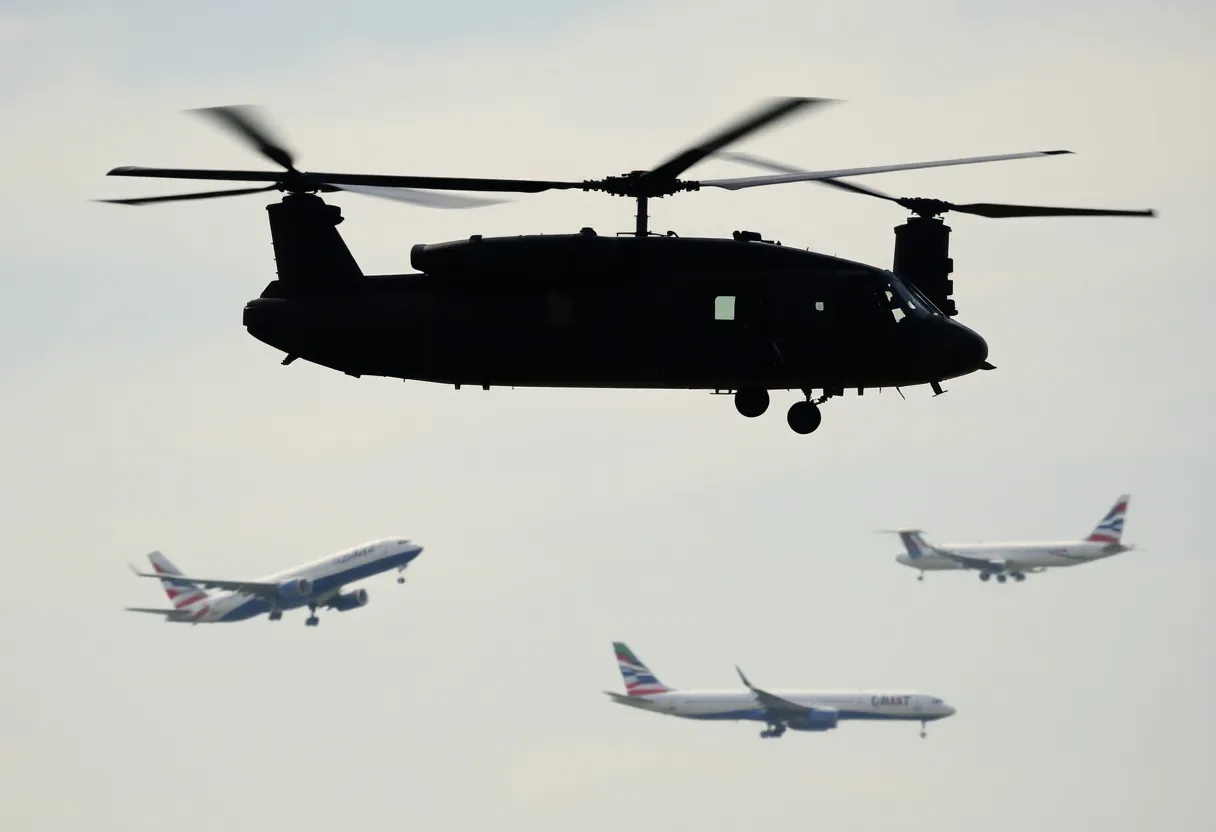News Summary
An Army Black Hawk helicopter caused two commercial flights, Delta Air Lines Flight 1671 and Republic Airways Flight 5825, to abandon their landings at Reagan National Airport on Thursday afternoon. The incident, prompted by an air traffic control directive amid concerns for safety, has sparked a significant investigation into aviation protocols. Both flights conducted successful go-arounds and landed without further incident. Key safety officials, including U.S. Transportation Secretary Sean Duffy, emphasized the importance of communication and regulatory compliance following the close call, as investigations by the NTSB and FAA are underway.
Army Helicopter Forces Two Commercial Jets to Abort Landings at Reagan National Airport
In a startling incident that unfolded on Thursday afternoon around 2:30 p.m., the skies over Reagan National Airport became a scene of concern when an Army Black Hawk helicopter prompted two commercial flights to perform emergency go-arounds. This unexpected maneuver has sparked a significant investigation into aviation safety protocols in this busy airspace.
What Happened?
As Delta Air Lines Flight 1671, an Airbus A319, and Republic Airways Flight 5825, an Embraer E170, approached their final landing, air traffic control instructed both flights to abort their landings due to the nearby helicopter heading towards the Pentagon. Thankfully, both planes successfully executed the go-arounds and landed safely without incident. However, the close call has raised several eyebrows among safety officials and passengers alike.
The Response
U.S. Transportation Secretary Sean Duffy quickly voiced his discontent, labeling the situation “unacceptable.” He emphasized the critical nature of aviation safety, especially following a tragic midair collision earlier this year that resulted in the loss of 67 lives. Duffy pointed out the need for immediate communication with the Department of Defense to address potential lapses in airspace regulations.
In light of this incident, the National Transportation Safety Board (NTSB) and the Federal Aviation Administration (FAA) have launched investigations to uncover the details surrounding the go-arounds. Secretary Duffy underscored the importance of stringent safety measures in air travel, and subsequent actions are being taken to ensure compliance with established protocols.
Army’s Position
The Army, on its part, has stated that its Black Hawk helicopter was following approved flight procedures, having received instructions from Pentagon air traffic control to perform a “go-around.” Interestingly, FAA Assistant Administrator Chris Senn noted that the helicopter took a more scenic route around the Pentagon, which led to the unforeseen go-arounds. This deviation raised concerns regarding the proper distance maintained between aircraft during landings, categorized as a “loss of separation” event.
Missing Radar Data
One of the key factors in the confusion was a radar glitch that prevented air traffic controllers from viewing the helicopter’s tracking position in real-time. This technological hiccup contributed to the uncertainty in air traffic control as both flights were on their final approach. At the closest point, the helicopter was recorded less than a mile and 400 feet from the two commercial aircraft.
Ongoing Investigations and Safety Measures
This incident is particularly alarming as it comes less than a week after the Army brigade began resuming flight operations in the National Capital Region. The fallout has led to increased scrutiny, with the FAA enhancing staffing and oversight for air traffic control operations at Reagan National Airport. Additionally, new regulations have been implemented to prevent the simultaneous use of certain runways when helicopters are nearby, aiming to fortify safety standards.
In a show of solidarity, Delta Air Lines reaffirmed its commitment to passenger safety and stated its willingness to cooperate with investigative authorities. Democratic Senator Maria Cantwell also expressed her outrage over the incident, echoing the sentiment that it is high time for both the Defense Secretary and the FAA to prioritize aviation safety in this critical corridor.
Looking Ahead
As the FAA continues to evaluate arrival rates at Reagan National Airport—recognized as having the busiest runway in America—it’s clear that the aviation community will be closely monitoring the outcomes of these investigations. The focus remains on safeguarding the skies and ensuring that all air traffic, both military and commercial, adheres to the strictest safety protocols.
Conclusion
This incident serves as a crucial reminder of the delicate balance required in managing multi-faceted air traffic systems. With all eyes on the upcoming findings, it’s evident that aviation safety will remain a top priority for regulators, airlines, and military operations alike.
Deeper Dive: News & Info About This Topic

Author: STAFF HERE ORLANDO WRITER
ORLANDO STAFF WRITER The ORLANDO STAFF WRITER represents the experienced team at HEREOrlando.com, your go-to source for actionable local news and information in Orlando, Orange County, and beyond. Specializing in "news you can use," we cover essential topics like product reviews for personal and business needs, local business directories, politics, real estate trends, neighborhood insights, and state news affecting the area—with deep expertise drawn from years of dedicated reporting and strong community input, including local press releases and business updates. We deliver top reporting on high-value events such as Orlando International Fringe Theatre Festival, Megacon Orlando, and Central Florida Fair. Our coverage extends to key organizations like the Orlando Economic Partnership and Hispanic Chamber of Commerce Metro Orlando, plus leading businesses in leisure and hospitality that power the local economy such as Walt Disney World Resort, AdventHealth, and Universal Orlando. As part of the broader HERE network, including HEREJacksonville.com, HEREPetersburg.com, HERETallahassee.com, and HERETampa.com, we provide comprehensive, credible insights into Florida's dynamic landscape.




